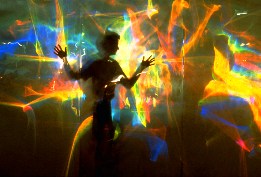| they can each individually be appreciated and enjoyed on a variety of levels. Secondly, it is ridiculous to think that every visitor should be able to appreciate or enjoy every exhibit in the museum. Most science centers have several hundred exhibit pieces. We have over 400, the Franklin Institute has over 600. How many of these should one expect a visitor to become memorably absorbed with in a two or three hour visit? How many paintings in the New York Metropolitan do you specifically want to go back and see on your next visit - 6? 12? 14? 48? We have one exhibit that I have never seen an unaccompanied person spend time at. It is an exhibit on images of point sources produced by holographically made zone-plate rings. But the exhibit is there if anyone ever asks how a standard holographic image is produced. We, and the Explainers, can take them to this "unused"' exhibit on zone plates, and occasionally knowledgeable visitors also use it to explain holograms to their companions. Not only should one not expect a visitor to become absorbed in very many exhibits, the atmosphere of the museum must be adjusted in such a way that people are relaxed about missing or not understanding something. I was especially delighted by one example of such relaxedness: We have painted over one of the skylights in the building to keep the optics section dark. However, the seagull feet | puncture star-like holes in the paint. On one occasion I overheard a middle-aged woman saying to her companion as both looked up at these holes, "Well, I suppose that if we knew more, we would know what the little lights meant". They were perfectly happy as they went on to play with other exhibits. An important general consideration of the Exploratorium stems from the central values we place on art. Many museums involve artists to help with the appearance and the graphics of their exhibitry. We have used artists in a parallel capacity to that of science teachers. Each contributes exhibits that deal with roughly the same domains of nature. We have, for example, many detailed didactic exhibits on | |||
 | ||||
The ever-changing Sun Painting by artist Bob Miller is one of the earliest art pieces in the museum. | ||||
| the dispersion of light into colors but we also have the magnificent constantly changing Sun Painting that was created by an artist using a palette of pure hues. that are extracted from the sunlight by an arrangement of long prisms and narrow mirrors. We have holograms purchased from artists displayed along with our didactic treatment of holograms and diffraction. Art is included, not just to make things pretty, although it often does so, but primarily because artists make different kinds of discoveries about nature than do physicists or biologists. They also rely on a different basis for decision-making while creating their exhibits. But both artists and scientists help us notice and appreciate things in nature that we had learned to ignore or had never been taught to see. Both art and science are needed to fully | ||||
 | ||||
Age is no barrier at many of the Exploratorium's exhibits. Each exhibit can be appreciated at many levels. | ||||